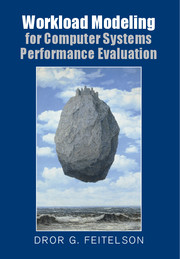Book contents
- Frontmatter
- Dedication
- Contents
- PREFACE
- 1 Introduction
- 2 Workload Data
- 3 Statistical Distributions
- 4 Fitting Distributions to Data
- 5 Heavy Tails
- 6 Correlations in Workloads
- 7 Self-Similarity and Long-Range Dependence
- 8 Hierarchical Generative Models
- 9 Case Studies
- 10 Summary and Outlook
- Appendix Data Sources
- Bibliography
- Index
10 - Summary and Outlook
Published online by Cambridge University Press: 05 March 2015
- Frontmatter
- Dedication
- Contents
- PREFACE
- 1 Introduction
- 2 Workload Data
- 3 Statistical Distributions
- 4 Fitting Distributions to Data
- 5 Heavy Tails
- 6 Correlations in Workloads
- 7 Self-Similarity and Long-Range Dependence
- 8 Hierarchical Generative Models
- 9 Case Studies
- 10 Summary and Outlook
- Appendix Data Sources
- Bibliography
- Index
Summary
Developing a model of a nontrivial system is itself nontrivial. There is no simple recipe that can be applied that promises good results. Instead, model building is usually an iterative and interactive process, involving three recurring steps: model formulation, model estimation, and model validation [121, sect. 4.8]. Most books, including this one, devote most of their attention to model estimation. This is the activity of matching a specific piece of a model to a given feature of the data. But one must not forget the big picture.
From Workload Data to Workload Model
In previous chapters we have described and compared many workload models in various domains. Here we want to summarize recurring principles and draw them together.
To recap, there are three main approaches to using workload data:
Find the simplest abstract mathematical model that captures a desired feature.
Use raw data as when driving simulations directly from traces, or using empirical distributions.
Create a generative model that could plausibly give rise to the observed data.
Perhaps the most entrenched and commonly used approach in workload modeling is to use a mathematical abstraction in the form of a statistical model. For example, the method of moments can be used to fit a marginal distribution, and an autocorrelation function is used to characterize the dependence structure and fit a long-range dependent fARIMA model. When a new workload feature is recognized as being important, mathematical modeling is often the first approach used to evaluate its effect. And doing so often leads to great advances in understanding the effect of the new feature.
But such abstractions can also miss out on important issues. Distributions with the correct moments can still have the wrong shape and taint detailed analysis. Moreover, descriptive mathematical models may actually lead to conclusions that do not really reflect the workload. For example, consider a study of a communication network that finds a negative correlation between packet sizes and the subsequent interval to the next packet.
- Type
- Chapter
- Information
- Workload Modeling for Computer Systems Performance Evaluation , pp. 490 - 494Publisher: Cambridge University PressPrint publication year: 2015



